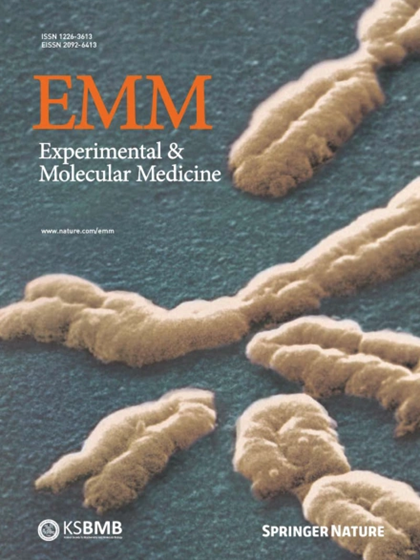ErbB4 precludes the occurrence of PTSD-like fear responses by supporting the bimodal activity of the central amygdala
IF 9.5
2区 医学
Q1 BIOCHEMISTRY & MOLECULAR BIOLOGY
引用次数: 0
Abstract
Post-traumatic stress disorder (PTSD) often arises after exposure to traumatic events and is characterized by dysregulated fear responses. Although the associations of erb-b2 receptor tyrosine kinase 4 (ErbB4) with various neuropsychiatric diseases, including schizophrenia and bipolar disorder, have been widely examined, the physiological roles of ErbB4 in PTSD and fear responses remain unclear. Using Cre-dependent ErbB4 knockout (KO) mice, we observed that PTSD-like fear behaviors emerged in ErbB4-deficient mice, particularly in inhibitory neurons. Specifically, the loss of ErbB4 in somatostatin-expressing (SST+) neurons was sufficient to induce PTSD-like fear responses. We also adopted the CRISPR/Cas9 system for region-specific KO of ErbB4, which revealed that ErbB4 deletion in SST+ neurons of the lateral division of the amygdala (CeL) caused elevated anxiety and PTSD-like fear generalization. Consistent with its physiological role, ErbB4 expression was diminished in CeLSST neurons from mice that exhibited PTSD-like phenotypes. While fear On and Off cells identified in the CeL displayed distinct responses to conditioned and novel cues, as previously shown, the selectivity of those On and Off cells was compromised in SSTErbB4-/- and stressed mice, which displayed strong fear generalization. Therefore, the bimodal activity that CeL On/Off cells display is likely required for proper discrimination of fearful stimuli from ambient stimuli, which should be sustained by the presence of ErbB4. Taken together, our data substantiate the correlation between PTSD-like fear responses and ErbB4 expression in CeLSST neurons and further underscore the functional effects of ErbB4 in CeLSST neurons, supporting the bimodal responses of CeL neurons. Post-traumatic stress disorder is a mental health condition that can develop after experiencing traumatic events. Researchers tried to understand the biological basis of PTSD using animal models. The researchers investigated the role of a protein called ErbB4 in fear responses related to PTSD. They used mice to study how deleting ErbB4 in specific brain cells affects fear behavior. They focused on somatostatin(SST)-expressing neurons in a brain region called the central amygdala, which is involved in processing fear. The study involved genetic modification, behavioral tests, and in vivo recording to observe changes in fear responses. The findings showed that removing ErbB4 from SST+ neurons led to increased anxiety and generalized fear, like PTSD symptoms, with specific alteration of neuronal activity. This suggests that ErbB4 helps regulate fear responses, and its absence may contribute to PTSD-like behaviors. This summary was initially drafted using artificial intelligence, then revised and fact-checked by the author.

ErbB4通过支持中央杏仁核的双峰活动来排除ptsd样恐惧反应的发生。
创伤后应激障碍(PTSD)通常在暴露于创伤性事件后出现,其特征是恐惧反应失调。尽管erb-b2受体酪氨酸激酶4 (ErbB4)与各种神经精神疾病(包括精神分裂症和双相情感障碍)的关联已被广泛研究,但ErbB4在创伤后应激障碍和恐惧反应中的生理作用仍不清楚。使用cre依赖性ErbB4敲除(KO)小鼠,我们观察到ErbB4缺陷小鼠出现了类似ptsd的恐惧行为,特别是在抑制性神经元中。具体来说,生长抑素表达(SST+)神经元中ErbB4的缺失足以诱导ptsd样恐惧反应。我们还采用CRISPR/Cas9系统对ErbB4的区域特异性KO进行了检测,结果显示,杏仁核外侧分裂(CeL) SST+神经元的ErbB4缺失导致焦虑升高和ptsd样恐惧泛化。与其生理作用一致,ErbB4在表现出ptsd样表型的小鼠CeLSST神经元中的表达减少。虽然在CeL中发现的恐惧开关细胞对条件和新线索表现出不同的反应,但如前所述,在SSTErbB4-/-和应激小鼠中,这些开关细胞的选择性受到损害,表现出强烈的恐惧泛化。因此,CeL On/Off细胞显示的双峰活动可能是正确区分恐惧刺激和环境刺激所必需的,这应该由ErbB4的存在来维持。综上所述,我们的数据证实了ptsd样恐惧反应与CeLSST神经元中ErbB4表达之间的相关性,并进一步强调了ErbB4在CeLSST神经元中的功能作用,支持了CeL神经元的双峰反应。
本文章由计算机程序翻译,如有差异,请以英文原文为准。
求助全文
约1分钟内获得全文
求助全文
来源期刊

Experimental and Molecular Medicine
医学-生化与分子生物学
CiteScore
19.50
自引率
0.80%
发文量
166
审稿时长
3 months
期刊介绍:
Experimental & Molecular Medicine (EMM) stands as Korea's pioneering biochemistry journal, established in 1964 and rejuvenated in 1996 as an Open Access, fully peer-reviewed international journal. Dedicated to advancing translational research and showcasing recent breakthroughs in the biomedical realm, EMM invites submissions encompassing genetic, molecular, and cellular studies of human physiology and diseases. Emphasizing the correlation between experimental and translational research and enhanced clinical benefits, the journal actively encourages contributions employing specific molecular tools. Welcoming studies that bridge basic discoveries with clinical relevance, alongside articles demonstrating clear in vivo significance and novelty, Experimental & Molecular Medicine proudly serves as an open-access, online-only repository of cutting-edge medical research.
 求助内容:
求助内容: 应助结果提醒方式:
应助结果提醒方式:


